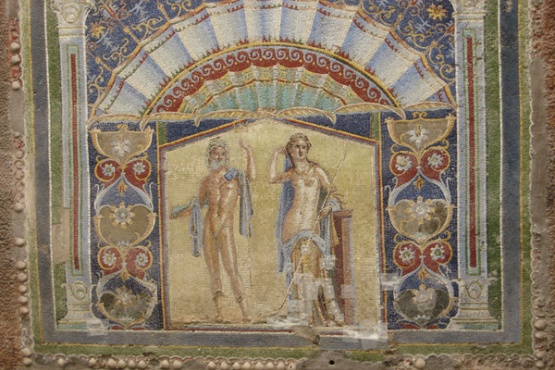Daily Life in Pompeii
On 24 August 79 AD, Mount Vesuvius erupted explosively, burying Pompeii under a crust of volcanic ash. For the next seventeen centuries, the city would remain lost, forgotten and preserved, sealed in a time capsule. Since excavations began in 1748, Pompeii was gradually revealed – street by street, building by building, room by room – providing an unparalleled record of life in the Roman Empire.
Explore this site to find out more about how the people of Pompeii lived and their culture and society. From social bathing to religious practices, businesses to public entertainment, the themes (listed in the menu) will provide the background to the objects you will see in A Day in Pompeii.
A jewel in the crown of the Empire
In 90 BC, a regional rebellion broke out against the Romans, and a year later the Roman Dictator Sulla besieged and captured Pompeii. Reprisals followed, and Pompeii transformed itself again, this time into a Roman colony. Latin became the official language, and a Roman constitution was imposed on the new colony.
-

- Roman Pompeii
- Source: © Museum Victoria
By the time Augustus became the first Roman Emperor in 27 BC, prominent Pompeians had become devotees of Roman fashion and custom. Pompeii had come a long way from its humble origins. Now a bustling town, it was home to about 10,000-12,000 people, with as many again living in the surrounding countryside. As Pompeii’s population increased, so did its urbanisation, as older houses were subdivided and upper storeys added to make room for the newcomers. The social structure underwent a shake-up, as the old ruling aristocracy began to lose ground to a new class of self-made men who built larger and showier villas in the Roman style.
Venus, Roman goddess of love and beauty
Material: Marble
Location: Villa of Poppaea, Oplontis
Venus, in mythology, sprang from the foam of the sea. Being reliant on the sea for its prosperity, Pompeii adopted her as its divine protectress and her temple overlooked the river and bay. Throughout the town the goddess was evoked in shrines, painted images, even graffiti. This statue stood in the gardens of a grand villa near Pompeii.
SAP No: 71252







